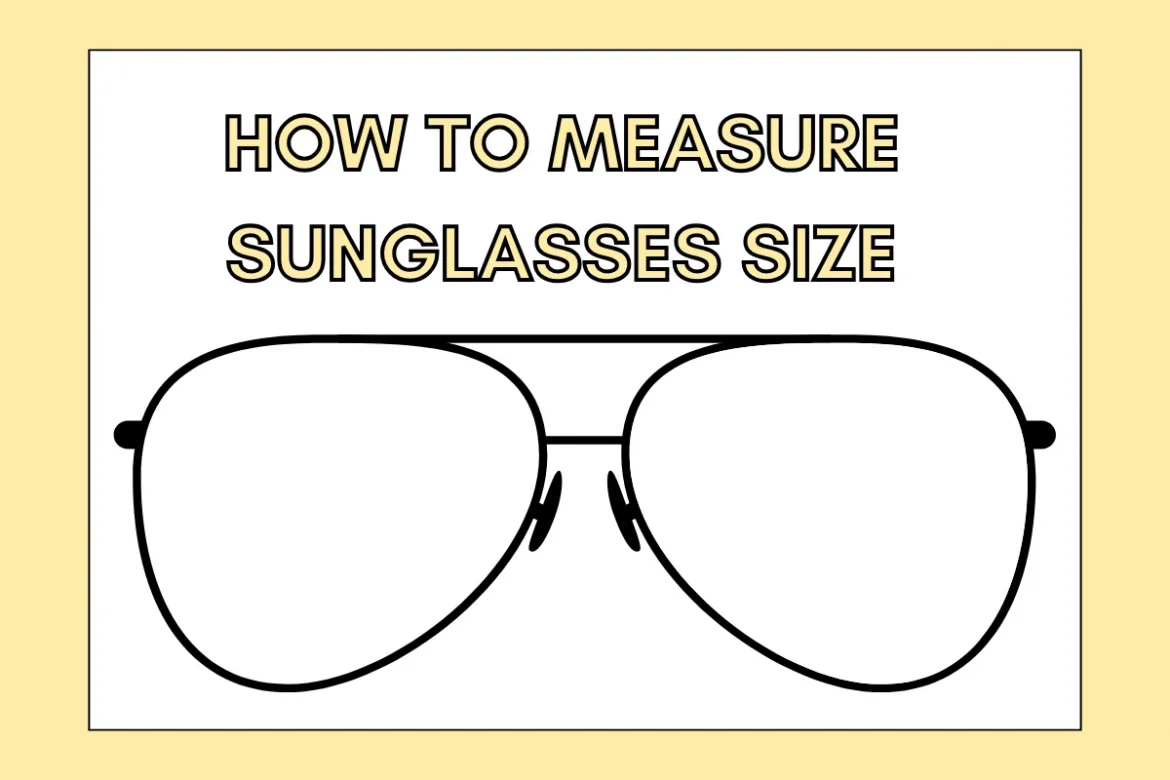The right sunglasses size is important for more than just style. A good fit ensures comfort during long wear, prevents slipping, and offers the best UV protection for your eyes. Wearing the wrong size can cause discomfort, leave marks on your nose, or simply not look right on your face shape.
This guide will show you how to measure sunglasses size both manually and by checking size details online. The process is simple, and once you understand it, you can confidently shop for any brand or style.
Whether you are looking for sunglasses for men or women, these tips apply to all designs, from fashion-forward frames to sporty styles. We will also explain what is Ray-Ban standard size so you can pick the perfect fit if you are a fan of this popular brand.
By the end, you will know exactly what numbers to look for and how to match them to your face for the best combination of style and comfort.
Understanding Sunglasses Size
Sunglasses sizes are usually made up of three main measurements: lens width, bridge width, and temple length. These numbers are often printed on the inside of the sunglasses’ arm.
- Lens width determines how wide the sunglasses look and how much coverage they give your eyes. Larger lenses can offer more protection but may feel oversized if they are too wide for your face.
- Bridge width affects how the sunglasses sit on your nose. A smaller bridge can make them sit higher, while a wider bridge gives more space for comfort.
- Temple length refers to the length of the arms. This affects how securely the sunglasses stay on, especially when you move around.

Brands like Ray-Ban clearly list these measurements for every model so you can check before you buy. Understanding these numbers helps you choose a pair that fits well, looks good, and stays comfortable all day.
What is Ray-Ban Standard Size?
Ray-Ban offers sunglasses in different sizes, such as Small, Standard, and Large. The Standard size is the most common and fits most people with average adult face shapes. It strikes a good balance between coverage and comfort without feeling too big or too small.
For example, the Ray-Ban Wayfarer in Standard size usually has a lens width of around 52 mm, a bridge width of 18 mm, and a temple length of 145 mm. Another popular model, the Ray-Ban Aviator in Standard size, often comes with a 58 mm lens width, 14 mm bridge, and 135 mm temple length.
If you are unsure which size to choose, Standard is a safe starting point for most men and women. It suits people who do not have a particularly narrow or wide face. Once you know these measurements, you can compare them to your current sunglasses for a perfect match.
How to Measure Sunglasses at Home (Step-by-Step)
You do not need special tools to measure your sunglasses. A simple ruler or a flexible measuring tape is enough. You can use your existing pair of sunglasses to get accurate numbers for your next purchase.
Step 1: Measure lens width
Place the ruler across the widest part of one lens, measuring from edge to edge. Write down the number in millimeters.
Step 2: Measure bridge width
Measure the distance between the two lenses at the part that sits on your nose. This helps ensure comfort and prevents slipping.
Step 3: Measure temple length
Stretch the arm of the sunglasses and measure from the hinge to the very end, following the curve. This tells you how securely they will stay in place.
Step 4: Measure frame width
Lay the sunglasses flat and measure from the far left edge of one frame to the far right edge. This shows the overall size and how they will fit your face.

Tips for accuracy
- Always measure in millimeters for precision.
- Take measurements on a flat surface to avoid bending the frame.
- Keep these numbers in a safe place so you can check them before buying sunglasses online.
How to Check Sunglasses Size Online
- Look for the size details on product pages. Most reputable eyewear brands include a sunglasses size chart mm, showing lens width, bridge width, and temple length in millimeters. This helps you compare and choose the right fit.
- Use brand size charts. Many brands like Ray-Ban or Oakley provide detailed size charts to guide you. These charts explain what each measurement means and suggest sizes for different face types.
- Try virtual try-on tools. Some websites offer online tools that use your webcam or photos to show how sunglasses will look on your face. This is a helpful way to check fit before buying.
- Check the model number on existing frames. Most sunglasses have a code printed on the inside of the temple arm. It usually includes numbers like 52-18-140, which stand for lens width, bridge width, and temple length in millimeters. You can use these numbers to find the exact size online or compare with other models.
- Always compare your measurements with the sunglasses size chart mm provided on the site to ensure you pick the best fit.

Measuring for Sunglasses for Men vs Women
- Men often prefer wider frames that provide more coverage and balance broader facial features. Sunglasses for men usually come in larger sizes to match this preference.
- Women tend to choose narrower or more stylized frames. These can be sleeker and may include fashion-forward designs that also prioritize comfort.
- Keep in mind that style and comfort are personal. Many people find frames outside traditional gender categories that suit them perfectly.
- When choosing sunglasses, focus on what feels comfortable and looks good on your face rather than strictly following gender norms.
- Understanding these trends can help guide your choice, but the best fit always depends on your unique face shape and personal style.
Tips for a Perfect Fit
- When choosing sunglasses, think about your face shape as well as the size. The right shape can highlight your best features and make the fit feel more natural.
- Adjustable nose pads are a great feature to look for. They help the sunglasses sit comfortably on your nose and prevent slipping, especially if you wear them for long periods.
- Lightweight materials like acetate or titanium make sunglasses easier to wear all day without causing discomfort or pressure points.
- If you buy sunglasses online, always check the return policy. This way, if the fit isn’t quite right, you can exchange or return them without hassle.
Common Sizing Mistakes to Avoid
- Don’t choose sunglasses based only on style. A trendy pair that doesn’t fit well can be uncomfortable and won’t look as good as a properly fitting pair.
- Ignoring the temple length is a common mistake. If the arms are too short or too long, the sunglasses may slip off or feel tight behind your ears.
- Always check the product specifications before buying. Knowing the lens width, bridge size, and temple length helps you pick sunglasses that suit your face.
- Remember that oversized sunglasses can still fit comfortably if they are proportionate to your face. Don’t avoid them just because they look big; try them on and see how they feel.
Conclusion
Knowing your sunglasses size is key to finding a pair that fits comfortably and looks great. Taking the time to measure your current glasses or face will save you from buying the wrong size, especially when shopping online.
Always check the official size chart of your favorite brand before making a purchase. This helps ensure the best fit and avoids returns or exchanges.
Yes, but choose oversized styles with angular or structured shapes that don’t overwhelm your face. Try them on to see if they feel balanced.
FAQs
How do I know my size in sunglasses?
You can measure your current sunglasses or your face using a ruler or measuring tape. Check the lens width, bridge width, and temple length in millimeters. These numbers tell you your ideal sunglasses size.
What size is 52mm in sunglasses?
A 52mm size usually refers to the lens width. It means the lens is 52 millimeters wide. This size is often considered small to medium and fits many people with smaller or average face sizes.
What does 55mm mean on sunglasses?
The 55mm measurement is also lens width. It means the lenses are 55 millimeters wide, which is slightly larger and can offer more coverage.
Are 57mm sunglasses big?
Sunglasses with a 57mm lens width are generally considered medium to large. They provide good coverage and usually fit people with wider faces.
How do I know if my sunglasses are too big?
If your sunglasses slide down your nose easily, feel heavy, or extend past your temples, they might be too big. A proper fit should feel secure but comfortable.
What is the average size for Ray-Ban sunglasses?
Ray-Ban’s average size is usually around 52mm to 54mm lens width with bridge widths of 18mm. This fits most adults comfortably.
Do sunglasses stretch over time?
Some frames made of flexible materials may stretch slightly, but most keep their original shape if handled carefully.
How do I read the numbers on my sunglasses arm?
Look for three numbers separated by dashes or spaces, such as 52-18-140. These represent lens width, bridge width, and temple length in millimeters.


